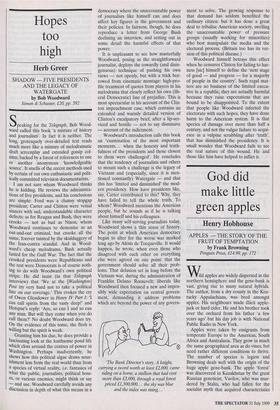God did make little green apples
Henry Hobhouse
APPLES — THE STORY OF THE FRUIT OF TEMPTATION by Frank Browning Penguin Press, £14.99, pp. 172 Wild apples are widely dispersed in the northern hemisphere and the gene-bank is vast, giving rise to many natural hybrids. The author, from a dry county in the Ken- tucky Appalachians, was bred amongst apples. His neighbours made illicit apple- jack or hard cider. He and his brother took over the orchard from his father 'a few years ago' but his day job is with National Public Radio in New York.
Apples were taken by emigrants from temperate Europe to the Americas, South Africa and Australasia. They grow in much the same geographical area as do vines, but need rather different conditions to thrive. The number of species is legion and Browning deals well with the origin of the huge apple gene-bank. The apple 'forest' was discovered in Kazakhstan by the great Russian geneticist, Vavilov, who was mur- dered by Stalin, who had fallen for the socialist myth that acquired characteristics can be inherited. ('What,' a French friend asked Lysenko, the chief myth-maker, 'hap- pens when you cut off the tail of a mother pig. Do the pigs of the next litter have no tail?') Out of the Kazakhstan forests of wild apples came genes of every kind.
Browning deals with apple pests which may cost so much in preventative chemicals that only great sales/luck can ever pay for the ultimate cost. He veers towards a mid- Green position, in contrast to. those who spray once every fifteen days or do not spray at all.
Some species are far more resistant to pests than others and geneticists are hard at work to combine commercial qualities with resistance to pests of every kind. It is worth mentioning that without limitations, the family would probably dominate the temperate zone. As it is, there are few places in the First World where apples can- not be bought to eat or to cook in every week of the year. Cider is another matter.
Because apples are much lower in sugar- content than grapes, wild yeasts are not killed by an alcohol-content of more than 4-5 per cent as they are in wine production. So real cider — rarely more than 5 per cent alcohol and called 'scrumpy' in the West Country — still contains many viable yeasts. This allows a second fermentation in bottle, but to make 'industrial' cider in huge tanker loads, synthetic yeasts have to be employed, in turn killed by pasteurisa- tion and the difference between still and bubbly cider is only carbon dioxide. Much so-called cider is made from imported apple concentrate by these means.
Browning vividly describes visits to Nor- man and Somerset cider-makers, romantic- ally regretting that the public prefers sweet synthetic liquors. At the same time, he grows eating apples that a lover of Cox's Orange Pippin would regard as soft, sweet, mushy fruit. But it is unlikely that Coxes would grow in Kentucky, as they do not grow any- where as well as they do in England.
The rule appears to be that in apple cul- ture, the inverse quality/quantity law applies and it is allied to the need to indus- trialise production because of marketing. This has led to a very real dearth of fine apples except for those lovingly grown in a garden. It is the concentrated culture of the same species in orchards that has led to this loss of quality. But the concentration (and the yield per acre) is critical for com- mercial success.
The sub-title should fool no one, the book being also about why so many apples no longer tempt the discerning, There are some modern varieties that would never have even tempted Adam and Eve.
Henry Hobhouse's Seeds of Change is pub- lished by Papermac at £l2



























































 Previous page
Previous page